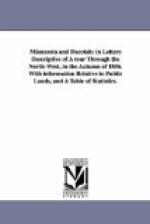It is estimated that 28,000 people have visited and left St. Paul during the present season. During July and August the travel diminishes, but as soon as autumn sets in it comes on again in daily floods. It is really a novel and interesting state of things one finds on his arrival at the hotel. There are so many people from so many different places! Then everybody is a stranger to almost everybody, and therefore quite willing to get acquainted with somebody. Everybody wants a bit of information on some point. Everybody is going to some place where he thinks somebody has been or is going, and so a great many new acquaintances are made without ceremony or delay; and old acquaintances are revived. I find people who have come from all sections of the country— from the east and the west, and from the south— not adventurers merely, but men of substance and means, who seek a healthier climate and a pleasant home. Nor can I here omit to mention the meeting of my friend, Col. A. J. Whitney, who is one of the pioneers of Minnesota, and with whom I had two years before travelled over the western prairies. A. H. Marshall, Esq., of Concord, N. H., well known as a popular speaker, is also here on a visit.
But what are the roads leading from St. Paul, and what are the facilities of travel to places beyond? These are questions which I suppose some would like to have answered. There is a road to Stillwater, and a stage, which I believe runs daily. That is the route now often taken to Lake Superior. This morning three men came in on that stage from Superior, who have been a week on the journey. The great highway of the territory extends as far as Crow Wing, 130 miles north of here. It passes St. Anthony and several important towns on the eastern bank of the Mississippi. In a day or two I intend to take a journey as far as Crow Wing, and I can then write with more knowledge on the subject.
A very pretty drive out of St. Paul is by the cave. This is an object worth visiting, and is about two miles out of the city. Three or four miles beyond are the beautiful falls of Minnehaha, or laughing water. The drive also takes in Fort Snelling. St. Anthony is on the east side of the Mississippi; Minneapolis is opposite, on the west side. Both places are now large and populous. The main street of St. Anthony is over a mile in length. One of the finest water powers in the Union is an element of growth to both towns. The lumber which is sawed there is immense. A company is undertaking to remove the obstructions to navigation in the river between St. Paul and St. Anthony. $20,000 were raised for the purpose; one-half by the Steamboat Company, and the other half by the people of St. Anthony. The suspension bridge which connects Minneapolis with St. Anthony is familiar to all. It is a fit type of the enterprise of the people. I forget the exact sum I paid as toll when I walked across the bridge— perhaps it was a dime; at any rate I was struck with the answer given by the young man who took the toll, in reply to my inquiry as I returned, if my coming back wasn’t included in the toll paid going over? " No,” said he, in a very good-natured way, “we don’t know anything about coming back; it’s all go ahead in this country.”




